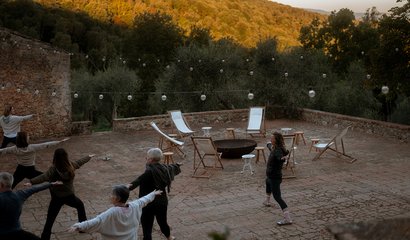July 3, 2025
What Every Yoga Teacher Should Know About Branding (Especially Online)
You can teach a great class, know your anatomy, and cue the breath like a pro—but in 2025, if you're a yoga teacher working online, that’s only half the job.
Somewhere between uploading your tenth class to your platform and wondering why no one watched your Reel, it hits: people aren’t just choosing yoga, they’re choosing you. Which means that your brand—yes, that word you might secretly resent—has already entered the room before you do.
But let’s not reduce it to a colour palette or a logo in the corner of your video. Your brand is the promise you're making to your students. It's how someone knows what they’re signing up for when they click play on your class. In the ecosystem of online yoga, where options are endless and attention is limited, that promise matters more than ever.
So what does that look like in practice, when you’re not a content marketer, just a teacher trying to do meaningful work? Let’s get into it.
You’re Already Branding Your Yoga—Whether You Mean To or Not
Even if you’ve never cracked open a Canva template, you still have a brand. It’s not just the fonts or the logo (though, yes, those matter). It’s how you name your classes, the way you cue movement, the photos you share between practices, and the stories you tell—or don’t.
With online yoga being mainstream, students can sample dozens of teachers with a tap, meaning your brand becomes shorthand for what someone can expect from you. If they’re looking for fast-paced fitness yoga and your class starts with three minutes of breathwork, they’ll click away. That mismatch? Branding.
Your brand is what sets the tone before a single pose. It tells your future students: “This is for you” or “This isn’t.” It does the filtering so you don’t have to.

Not Everyone Needs to Like You (That’s the Point)
Trying to be everyone’s cup of tea is the fastest way to get lost in the algorithmic sea of online yoga teachers. Chasing trends and can mean that one week you’re all-in on playful sequencing. The next, it’s stoic stillness and slow holds. You post a Reel with a trending sound even though it doesn’t sound like you. The result? A brand identity that’s more shape-shifting than sustainable.
A clear brand doesn’t make you rigid, it gives you roots. And from those roots, you can grow in new directions without losing people along the way. It is the beauty of seeing brand as a living entity, stable and full of possibility.
If your teaching is heartfelt, body-aware, and infused with modern movement science—own that. Don’t dilute it for reach. Instead, focus on resonance. A niche, well-served audience is far more loyal than a flaky, vague one.
A Yoga Brand Is a Mirror, Not a Mask
Let's address the tension: many yoga teachers recoil at the word "branding." It can feel artificial, even contradictory to a practice rooted in authenticity and presence.
But what if you reframed it?
Instead of seeing your brand as a costume, think of it as a mirror—one that reflects what you care about, how you teach, and the values you carry into the room (or onto the screen).
At Heart + Bones, the brand doesn't come from focus groups or trends. It's shaped by lived experience, honest conversations, and the simple but radical idea that yoga should feel good and do good. That's what draws people in—and keeps them around.
When your brand matches your values, you attract your ideal yoga students naturally. They enjoy your classes because you're being authentic, not performing.
In Online Yoga, Consistency Builds Trust
In a physical studio, your presence—the lighting, the way you greet people, the smell of the room—does a lot of heavy lifting. Online? You're working with pixels and scroll speed. You don't have time to warm people up with small talk or ambiance.
This is why consistency becomes your best friend.
When your emails match your Instagram captions, your class previews feel like your full-length videos, and your website reflects your teaching style—people trust you faster. They feel like they know you. And in online yoga, where connection is the currency, that's everything.
Consistency isn't about sameness. It's about recognizability. It helps people feel like they've arrived somewhere familiar, even if it's their first time pressing play. It also removes the pressure to constantly generate new ideas. You get to focus on what you excel at and continue attracting students who resonate with your approach!
How to Start Branding Your Online Yoga Teaching
You don’t need a logo, tagline, or colour palette to begin—but you do need to start thinking like a teacher who knows why they’re teaching.
Hiring a designer won’t solve this. Algorithms won’t solve this. Even the best marketing advice can’t substitute for the foundational work of figuring out what your teaching stands for—and who it’s really for.
So before you stress about visuals, focus here:
- What do students often say after class that surprises or affirms you?
Their words reflect what you’re actually known for—not what you think you’re projecting. - What do you say often without realizing it?
These phrases are the seeds of your voice. They’re often more memorable than your bio. - What moments in class feel most like you?
The parts where you stop mimicking and start owning. - Who returns again and again—and what do they have in common?
Your audience helps define your brand. Knowing who sticks around tells you who you're truly serving. - What feeling do you want people to leave your class with—every single time?
If you only answered this, you’d already be ahead of most yoga teachers trying to build online.
This is where your brand lives. From this foundational work you can begin to think about visuals and marketing. But with this started, if you are already online or on social media, you can begin to craft content that speaks to your dream yoga students.
The online yoga space isn’t oversaturated, it’s under-differentiated. The more you sound like yourself, the less you’ll have to compete. Because in a world full of yoga teachers, what people are really looking for… is one they can trust.
Ready to build a teaching practice that reflects you?
Our anatomy-informed, modern Online Yoga Teacher Training helps you do just that. Learn to teach with confidence, clarity, and care—wherever you are.
How to Start Building Your Online Yoga Brand
You don't need a logo to get started, but you do need a point of view.
Before anyone can help you design a brand, you need to understand what you're building and why it matters. That clarity is the foundation.
This is the part most people skip, and then pay for later with confusion, burnout, or a complete rebrand.
Give yourself the space to figure out what's already working and what you want to grow into. From there, you'll make smarter, more aligned choices—and your online yoga brand will naturally take shape.
Start with these four focus areas to develop practical answers and get your brand onto paper.
1. Name or Brand? Solo or Scalable?
Before you go any further, consider this:
- Are you building a personal teaching presence—or something that could one day grow into a platform, community, or team?
- Do you want students to connect with you, or with something that could expand beyond you?
If you're clear that it’s just you and will always be just you, your name might be the brand. But if you plan to grow—add teachers, create programs, build something bigger—then choose a brand name that isn’t tied to your identity.
Example: Heart + Bones wasn’t named after its founder, Brea Johnson. That decision made it easier to evolve into a collaborative studio with multiple teachers and offerings.
Action: Write down the version of your work five years from now. Would it feel odd if your name was still the centre of the brand?
2. What Do You Already Communicate—Without Trying?
Your brand already exists. You just might not have seen it yet.
Ask yourself:
- What do students often thank me for after class?
Not just “great class,” but the specifics. Do they mention clarity? A-ha moments? Feeling safe? - What phrases or cues do I repeat often—without even noticing?
These are the beginnings of a recognizable voice. Your students may already be quoting you. - What moments in class feel the most me?
Teaching isn't performance—but there are usually moments where you feel especially grounded, honest, or energized. That’s your voice.
Action: Record yourself teaching. Listen for what comes up again and again. These patterns are often invisible from the inside.
3. Who Are You Really Teaching—And Is That Who You Want to Teach?
Forget ideal client templates for a second. Let’s start with your real students—the ones who stick around.
Ask yourself:
- Who keeps coming back?
- What do they have in common?
- What do they say they love about your teaching?
- What kinds of questions or struggles do they bring into class?
This helps reveal who your current brand is resonating with, whether you meant to or not.
But here’s the twist:
Sometimes we attract students who aren’t quite the right fit. Not because they’re doing anything wrong—but because we’ve been shaping our teaching (and our marketing) around what’s popular instead of what’s authentic.
You might see fast-paced vinyasa everywhere on Instagram and feel pressure to teach the same—even if what you really want is to teach chair yoga, restorative, or a more functional approach to movement. Over time, this mismatch becomes exhausting. Your brand becomes unclear, and so does your audience.
Action: Write down three students you know well.
What do they share? What made them trust you?
Then ask yourself:
If I could fill a room with any kind of student, who would they be?
And: Am I creating content and classes that speak directly to them—or to what I think I should be offering?
This is your chance to align what you teach with who you want to reach. That alignment is the beginning of a sustainable, authentic brand.
4. What Do You Want to Be Known For?
Every teacher teaches movement. That’s not the differentiator. What else do you offer?
- A mindset shift?
- A feeling of safety?
- A grounded, science-informed lens?
- Permission to go slow?
Ask yourself:
What is the emotional experience I want people to leave with, every single time?
That’s your brand promise.
Action: Finish this sentence:
After my class, I want people to feel…


